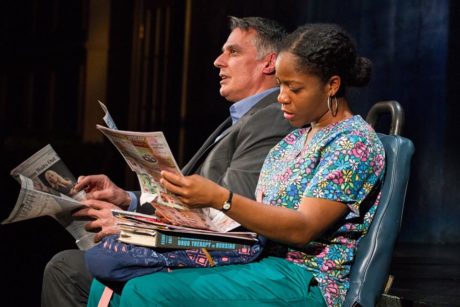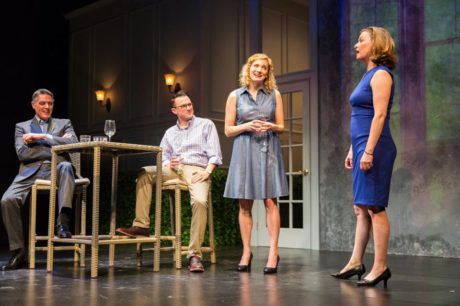White Guy on the Bus, at Wilmington’s Delaware Theatre Company through Sunday, February 19, is easily the prolific Bruce Graham’s most important and most accomplished play, even more than Coyote on a Fence or Funnyman. It shrewdly and bravely depicts American attitudes toward race, showing the casual and fairly harmless way racial matters creep into daily life while astutely addressing the prickliness of race – as well as some of racism’s ugliest manifestations.

Graham writes honestly and accurately. He clarifies degrees of racial byplay, from the benign to the overt and cynical, and he does so by using the playwright’s best friends: a strong and realistic story that sidles into situations, and dialogue in which offense, perceived or genuine, is spouted in an offhand manner.
With his knack for capturing the way people speak and his sense of giving matters perspective and proportion, Graham entertainingly and dramatically shows race relations in action. Director Bud Martin follows Graham’s lead with a production that unfolds naturalistically, giving each scene room to make its point, add to White Guy’s continually burgeoning impact, and breathe in its own space.
Martin’s pacing and choice to let the story tell itself, without pushing on overemphasizing anything, enhances White Guy’s depth and texture so that his production, as well as Graham’s play, evolves from the recognizable to the wrenching and controversial. White Guy on the Bus is a play that can open discussion and open eyes. Martin’s production, coming after Michelle Tattenbaum’s for Trenton’s Passage Theatre last season, confirms the worth of this play which, I hope, will be seen nationwide.
Graham is an experienced hand. He knows better than to clobber his audience with his point from Moment One. White Guy on the Bus begins with a conversation between a middle-aged suburban couple, Ray and Roz, about domestic matters, such as whether they need such a big house and when they might retire. Ray is a “numbers man” who owns and runs a financial advising firm. (Martin opens his production and several scenes with the stage turning into a gigantic stock market tote board.) Roz is a teacher in the Philadelphia ghetto, dedicated to her students and selfless enough to spend time after school to tutor kids who can’t read, one, Nazeer, in particular.
Race enters the picture – a “big picture,” to use a favorite expression of Ray’s – incidentally. Ray and Roz are having dinner at the home of their surrogate son, Christopher, who has been an integral part of their lives since he was age four and sought their company in lieu of his frequently absent parents. Also present is Christopher’s fiancée, Molly, of whom Ray and Roz, especially Roz, disapprove.

Interspersed with scenes regarding Christopher’s doctoral dissertation (about black and Asian characters in advertising), and Molly (a private school teacher) lightly but pointedly sparring with Roz about how race affects their roles as teachers, are sequences that show Ray on a bus. That bus has one major destination, Philadelphia’s county prison, and is populated mostly by black women and children. Ray, the white guy on the bus, is along for the ride.
Ray always sits alongside Shatique, a nursing student who weekly visits her brother, Sharif, convicted of gunning down multiple people on a corner and about to be sentenced to life without parole.
Shatique and Ray have a lively dialogue. We learn about Shatique’s ambition for herself and her eight-year-old son. Shatique yearns for a nice house and car and life in a place that is peaceful, without the pressures of the housing project where she lives among “crackheads” and worse.
Because Graham juggles time, showing Ray’s meeting with Shatique out of sequence with scenes involving Roz, Christopher, and Molly, it takes a while to learn Ray’s motive for riding the bus to the jails when he has a Mercedes and has no one to visit.
That’s when Graham shocks by illustrating the seamy side of racism and using to it to show some worldly realties and an ample dose of human nature. Ray’s morality comes into question as he employs his wealth, power, and shrewdly skewed logic to persuade Shatique and Sharif to assist him in a matter critical to him and financially beneficial to them.
Is Ray a realist or a villain? Or both? Shatique is certainly compromised and has to weigh some conventional principles against glaring pragmatism.
Graham lays out his ideas with brilliant precision and smart dialogue. Martin builds to high points and helps various characters’ dilemmas unfold grippingly while keeping a sense of controversy and suspense in the air.

The excellent work of the playwright and director carries over to Martin’s cast.
Danielle Lenée has experience playing Shatique, having done the role in Trenton as well as in Wilmington. Time has added nuance to her already intense and smart performance. Lenée reveals all aspects of Shatique. She is not a type or a cipher. She is a woman of character faced with a choice that challenges some tenets of that character. All kinds of perceptiveness and emotion come through. Lenée did sterling work in Trenton and ups the ante in Wilmington.
Robert Cuccioli is nicely cool as Ray. He obviously sees and realizes the value of the big picture he always talks about. He is a man at the top of any game he is playing. He is accomplished, honorable in business, realistic about life, and motivated to use his skills in less than admirable ways when the situation warrants it.
Cuccioli concentrates on Ray’s brains, daring, and belief he can convince anyone to do anything. Especially if what he offers is, in significant ways, in the other person’s best interest. He also conveys a man who is totally comfortable and confident within himself.
Of all the characters, Roz has the most perspective, one that surpasses Ray’s big picture. She states the case for a rational middle. Susan McKey shows the fire in Roz, the need to put things on solid realistic terms instead of bowing to sociological fashions of a time.
Jessica Bedford grows with every performance. Between White Guy on the Bus and the previous Delaware Theatre Company offering, The City of Conversation, she has spent this season playing outspoken young women who challenge the ideas of past generations. She plays Molly wonderfully here, with strong notes of conviction and reality.
Jonathan Silver is a congenial Christopher, smiling rather than taking sides between his fiancée and his mother figure. Silver is especially strong in a scene is which he describes the head of his department’s negative reaction to his dissertation.
Wade Laboissonniere’s costumes are perfect for Graham’s characters, helping to define their tastes and personalities and show their urban or suburban nature. Paul Tate DePoo III’s split set neatly suggests the atmosphere on a bus as it shows us the opulent and makeshift worlds of the main characters.

Running Time: Two hours, including an intermission.
White Guy on the Bus plays through February 19, 2017, at Delaware Theatre Company – 200 Water Street, in Wilmington, DE. For tickets, call the box office at (302) 594-1100, or purchase them online.




